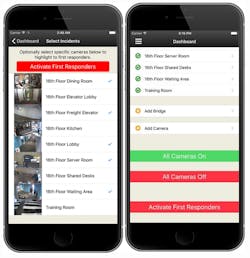Eagle Eye Networks, a provider of cloud-based video management systems, announced on Thursday that it is rolling out a new feature for its customers that will enable them to instantly share access to live video streams with first responders in the event of an emergency. The feature, dubbed “First Responder Real-Time Video Access,” gives users the option to pre-designate first responders who can receive immediate real-time access to cameras onsite to provide them with immediate situational awareness.
“Obviously, that can be very important to first responders when they’re first showing up on the scene so that they can see what is going on and know what they’re walking into,” said Dean Drako, president and CEO of Eagle Eye Networks. “It can also basically be a response multiplier where people offsite, back at police headquarters or elsewhere, can be looking at things and directing folks on what they should be doing and how they should be doing it. This is really an ideal application of cloud technology.”
"Giving public safety officers the ability to share live video surveillance cameras on smart phones during an emergency is a game changer in operational scenarios,” said Dr. Erroll G. Southers, former FBI special agent, and current managing director of counterterrorism and infrastructure protection at TAL Global. “During a crisis, real-time situational awareness and streamlined decision making can be the difference in protecting the public and first responders during life and death situations.”
However, unlike many current video sharing initiatives that provide law enforcement or other agencies with unfettered access to camera networks that reside within local school districts or municipal transit authorities, for example, this feature allows users to restrict the ability of authorities to view their surveillance assets only during an emergency event. In addition, users also have the ability to restrict what cameras first responders will have access to during an emergency situation. This not only helps provide authorities with the intelligence they need, but it also helps users adequately address any privacy concerns they may have which could have potentially held them back from sharing video previously.
Perhaps the biggest benefit of this new capability, according to Drako, is that it doesn’t require the purchase of any additional equipment or software on their part. All they have to do is download the free Eagle Eye Viewer mobile app, ‘accept’ the request sent by the system administrator of the entity that wants to share video and they’re ready to go.
“It gives (first responders) access to video only when it’s desperately needed, so that’s one capability that’s nice but I think there are two forms of real frustration when it comes to sharing cameras in the current world: one is the memorandums of understanding and all of the legalities of those kinds of cooperation agreements between different organizations. We’ve created this enable/disable functionality so that the end user can control it in a fashion that they are comfortable with, so people get a lot less uptight,” said Drako. “The other key aspect of it though is that there is no compatibility issues, there’s no Internet access issues and there’s no, ‘How do we hook this up from one system to another system kind of thing because it is all in the cloud and it’s all web and mobile app-based that are all free. There is no hardware or systems that have to be installed… and that removes a lot of technical hurdles which I think is going to be even more significant.”
Here is how the First Responder Real-time Video Access process works in its entirety:
- First Responder Pre-designation. System administrators use the Eagle Eye Security Camera VMS dashboard to pre-designate their list of first responders who will be authorized to view the video during emergencies by entering their respective names and email addresses into the system. There is no limit on how many different first responders can be added to the list. System admins will also authorize specific internal personnel that are capable of activating the emergency video feed.
- Closed Loop Confirmation. To ensure that the connection is made, after the administrator submits the first responder names and email addresses, each first responder will get a notification email and ‘accept’ the request. The first responders will also download the free Eagle Eye Viewer mobile app so they will be able to instantly view the video while in transit during an emergency.
- Activation during Emergencies. Following setup, the video streams will continue to be private – only accessible by the organization - until authorized personnel activate the video access. As a safeguard to avoid accidentally sending emails the user will also click on an “are you sure you want to activate?” notice to confirm. Once the emergency video access is enabled, all designated first responders can view video from any major web browser or the Eagle Eye Viewer iOS or Android mobile app.
- Activation Emails with Links to Relevant Video. As previously mentioned, the organization’s authorized personnel have an option to identify specific cameras for the first responders to view. All designated first responders will receive an email which includes direct links to the specified cameras.
- Force Touch. This feature, which is unique to users of newer iPhone models, enables an authorized person that is facing direct danger with insufficient time to launch the application by simply using “force touch” on the application icon on their phone, plus one confirming tap.
- Open API for Emergency Notification System Integration. Eagle Eye Networks has an open RESTful Eagle cloud video API to allow the organization’s physical security teams to integrate the first responder video emails and access with emergency notification systems they may have in place for first responders.
All Eagle Eye customers will have access to this new feature beginning May 1.



